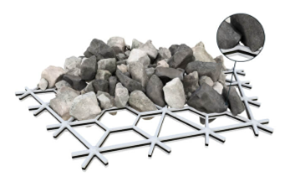The shape of things
by Jonathan Cook, on September 17, 2020
Research has shown that Tensar TriAx is more effective at stabilising granular layers and improving overall road pavement performance than Tensar biaxial geogrid – it all comes down to TriAx’s unique shape.
Tensar’s geogrids have been used to stabilise granular layers in road pavements for more than 35 years. Mechanically stabilised layers are proven to be a cost-effective way of reducing surface deformation of a road under dynamic traffic loads.
Why Tensar TriAx is more effective than biaxial geogrid

Tensar TriAx was a huge leap forward when it was launched in the UK in 2007. TriAx was introduced following five years of development by Tensar, with performance testing by the UK Transport Research Laboratory. Since then, the benefits of TriAx in flexible pavement design have been demonstrated through accelerated pavement testing by the US Corps of Engineers.
A key finding was that the shape of the geogrid dictates, to a large degree, its effectiveness in responding to the load pattern passing through the road pavement. Researchers demonstrated the load pattern caused by passing traffic is conical, radiating out 360° from the point of contact. So, when the load encounters a geogrid, the footprint is near circular.
TriAx’s hexagonal shape responds more effectively to this load pattern than the square shape of Tensar biaxial geogrid and so is far more effective in improving the performance of the resulting mechanically stabilised layer.



.jpg?width=400&height=400&ext=.jpg)
 Tensar InterAx has a unique geometry and utilises coextruded polymer technology to deliver exceptional performance.
Tensar InterAx has a unique geometry and utilises coextruded polymer technology to deliver exceptional performance.